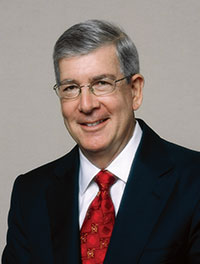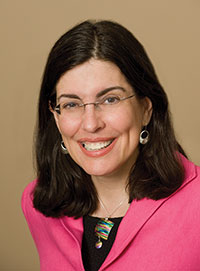RSNA Awards Gold Medals to Drs. Becker, Lichter and Pisano
Released: December 02, 2014
- RSNA Media Relations
1-630-590-7762
media@rsna.org
CHICAGO, Dec. 2, 2014 — Today the Radiological Society of North America (RSNA) conferred its highest honor, the Gold Medal, upon Gary J. Becker, M.D., Allen S. Lichter, M.D., and Etta D. Pisano, M.D.
In a tradition that originated in 1919, Gold Medals are presented each year to individuals who have rendered exemplary service to the science of radiology and who have received unanimous approval by the RSNA Board of Directors.
Gary J. Becker, M.D.
Over the course of his remarkable 36-year career in radiology, the name Gary J. Becker, M.D., has become synonymous with the word "leader."
"Dr. Becker has worked to improve the field of radiology through research and education," said 2014 RSNA President N. Reed Dunnick, M.D. "As RSNA Board Liaison for Science, he recognized that imaging must become quantitative if it is going to become a useful biomarker and was instrumental in developing the Quantitative Imaging Biomarkers Alliance."
"The RSNA's unparalleled culture, policies, programs and services are the soul of radiology," Dr. Becker said. "Although I have been privileged to serve the RSNA in many capacities, I can say without a doubt that I have gained both personally and professionally far more than I have given to RSNA. I am deeply honored and humbled to accept this award."
In addition to serving as 2009 RSNA President, Dr. Becker served as executive director of the American Board of Radiology (ABR) from 2007 until his retirement in mid-2014. Among his many accomplishments, Dr. Becker oversaw ABR's critical transition from oral to computer-based exams for certification in diagnostic radiology.
A renowned expert in interventional radiology, Dr. Becker was an early pioneer of transcatheter thrombolytic therapy and later of endografting for the treatment of aortic aneurysm. As a researcher, Dr. Becker developed new metallic stents for the treatment of coronary, peripheral and carotid arterial disease, a field in which he holds 10 patents.
Dr. Becker is a Chicago native who earned his undergraduate and medical degrees from Indiana University, where he completed his residency in diagnostic radiology and served as a professor and chief of the vascular section. In 1990, after 20 years at Indiana University, he moved to Miami Cardiac and Vascular Institute serving as director of interventional radiology and, ultimately, as assistant medical director of the institute and medical director of clinical research until 2004.
After 18 months as branch chief of image-guided intervention in the Division of Cancer Treatment and Diagnosis at the National Cancer Institute, he moved to the University of Arizona in 2005, serving as professor in the interventional section of the Department of Radiology.
Dr. Becker's lengthy ABR association includes serving six years on the ABR Board of Trustees followed by two years as associate executive director for diagnostic radiology and subspecialties. As ABR executive director, Dr. Becker oversaw the transition in certification exam format, established two new ABR exam centers and introduced the continuous certification process for ABR's maintenance of certification program. In addition, he successfully guided ABR's proposal for a new primary certificate in interventional radiology and diagnostic radiology (IR/DR certificate) through the approval process at the American Board of Medical Specialties.
An RSNA member since 1979, Dr. Becker joined the Board of Directors in 2001, serving as secretary-treasurer designate for one year and then Board liaison for science for four. He then served as Board chairman, president-elect and president. Prior to joining the Board, Dr. Becker had served the Society in many other capacities, including Radiology Editorial Board member, consultant to the Radiology Editor, and member of the Research Development Committee and Public Information Advisory Board. Dr. Becker was the opening session speaker at two annual meetings, a panelist of the Image Interpretation Session, and at RSNA 2000 delivered the Annual Oration in Diagnostic Radiology, "The Future of Interventional Radiology." Dr. Becker served as a trustee of the RSNA Research & Education Foundation from 2007 to 2009.
Dr. Becker has served in leadership roles with the Academy of Radiology Research, American Roentgen Ray Society, American College of Radiology, Association of University Radiologists, and numerous local radiologic societies. His 28 years of involvement with the Society of Interventional Radiology (SIR) included nine years on the executive council. In 1995, SIR re-named its award for the outstanding paper presentation by a young investigator, "The Dr. Gary J. Becker Young Investigator Award." He received the SIR gold medal in 2008.
Founding editor of the Journal of Vascular and Interventional Radiology, Dr. Becker has served as a manuscript reviewer, editorial board member, associate editor and editor for more than 20 journals. He has published 226 articles, 36 book chapters and one book.
In recognition of his contributions to the field of interventional radiology and his accomplishments as a radiologic leader, RSNA is proud to present Gary J. Becker, M.D., with its Gold Medal.
Allen S. Lichter, M.D.
With his career of world renowned achievements in cancer research, education and clinical care, there has been no one in a better position than Allen S. Lichter, M.D., to lead his peers—some 30,000 physicians and health professionals in oncology—in their trademark goal of "conquering cancer." Dr. Lichter has served as chief executive officer of the American Society of Clinical Oncology (ASCO) since 2006.
"Few people have made as many and as varied contributions to our field as Allen Lichter," said 2014 RSNA President N. Reed Dunnick, M.D. "His research using lumpectomy and radiation therapy to treat breast cancer gave women an alternative to mastectomy. He pioneered the development of '3-D therapy.'"
"I am deeply honored to receive this recognition from RSNA," Dr. Lichter said. "The imaging sciences are a fundamental part of cancer care. I have been privileged to work at that intersection and look forward to seeing the collaboration between oncology and radiology increase even more in the years ahead."
Dr. Lichter earned bachelor's and medical degrees from the University of Michigan in Ann Arbor. He trained in radiation oncology at University of California, San Francisco, before joining the faculty at The Johns Hopkins University and later the National Cancer Institute (NCI).
With research focusing on breast cancer treatment, Dr. Lichter was an early advocate of the breast conserving approach and while at NCI conducted one of the trials that found the use of lumpectomy and radiation therapy to be as effective as the traditional treatment of mastectomy. This work, along with other trials conducted in the U.S. and Europe, subsequently revolutionized breast cancer treatment standards.
Dr. Lichter served as the director of the Radiation Therapy Section of the NCI's Radiation Oncology Branch. His research and development of 3-D treatment planning led to a gold medal from the American Society for Therapeutic Radiology and Oncology (now the American Society for Radiation Oncology). In 2002, he was elected to membership in the Institute of Medicine of the National Academies of Science.
Dr. Lichter returned to the University of Michigan to serve as chair and professor of radiation oncology from 1984 to 1998 and as dean of the medical school from 1998 to 2006. He was named the first Isadore Lampe Professor of Radiation Oncology and also served as the Newman Family Professor of Radiation Oncology. Dr. Lichter introduced an innovative curriculum, oversaw creation of a new Biomedical Science Research facility, and was known as a prolific fundraiser in support of the medical school mission, with more than 70 endowed professorships established during his tenure. During his time at Michigan, Dr. Lichter was also credited with establishing a network of faculty to provide service around the state.
His tenure with ASCO has been no less impressive. While leading the Alexandria, Virginia-based organization—which marks its 50th anniversary this year—Dr. Lichter has overseen projects including a rapid learning system called CancerLinQ™, clinical practice guidelines and a quality care symposium. He also has led the development of the Quality Oncology Practice Initiative, an oncologist-led, practice-based quality assessment and improvement program. His tenure also has seen the launch of ASCO International and the renaming of the society's philanthropic arm as the Conquer Cancer Foundation, of which Dr. Lichter was founding chairman. Prior to assuming the CEO position, Dr. Lichter served in many volunteer roles with ASCO, including as president.
Dr. Lichter served as co-editor of Oncology from 1999 to 2005 and in editorial positions with the Journal of the National Cancer Institute, International Journal of Radiation Oncology, Biology, Physics and Journal of Clinical Oncology. He is an honorary member of the American Association of Physicists in Medicine and the Belgium Society for Therapeutic Radiology.
Dr. Lichter presented the Annual Oration in Radiation Oncology, "The Cost of Cancer Care: Near-Term Strategies and Long-Term Solutions," at RSNA 2007. RSNA is pleased to welcome Dr. Lichter back to the annual meeting and present him with the RSNA Gold Medal in recognition of his contributions to cancer research, education and clinical care, and leadership of his peers in clinical oncology.
Etta D. Pisano, M.D.
Women, in particular, and radiology, in general, owe a debt of gratitude to Etta D. Pisano, M.D., for her tireless efforts to develop, apply and test imaging technology for the early detection and diagnosis of breast cancer and other breast problems.
Dr. Pisano, a world-renowned breast imaging expert, has broken down barriers in her professional career, becoming the first woman dean of the College of Medicine at the Medical University of South Carolina (MUSC) in 2010. But her biggest contributions to radiology have been the research and testing she has done to integrate emerging technology into breast imaging. Her groundbreaking study, Digital Mammographic Imaging Screening Tool (DMIST), was the largest clinical trial ever led by a radiologist, and provided essential information about the efficacy of digital mammography.
"A physician, radiologist, investigator, teacher, wife and mother, Etta Pisano is a wonderful role model for professional men and women," said 2014 RSNA President N. Reed Dunnick, M.D. "Her successful research has played a major role in improving the quality of care radiologists provide."
"I am humbled and deeply honored to receive the RSNA Gold Medal," Dr. Pisano said. "I have been very fortunate to have enjoyed a fulfilling and stimulating career in radiology and am grateful for the support of my colleagues, mentors and family throughout the years."
Dr. Pisano served MUSC as vice president for medical affairs and dean of the College of Medicine from 2010 to 2014. Prior to her positions at MUSC, Dr. Pisano served in numerous positions at the University of North Carolina at Chapel Hill, including vice dean for academic affairs in the School of Medicine, Kenan Professor of Radiology and Biomedical Engineering, founding director of the Biomedical Research Imaging Center, and director of the Translational and Clinical Sciences Institute. From 1989 until 2005, she served as founding chief of breast imaging at UNC Hospitals.
Dr. Pisano received an undergraduate degree in philosophy from Dartmouth College and earned her medical degree from Duke University. She completed her radiology residency at Beth Israel Hospital of Harvard Medical School and remained at the institution as chief of breast imaging and instructor in radiology for one year. In 2003, she was appointed the first director of the UNC Biomedical Research Imaging Center (BRIC), a core facility that develops and commercializes new imaging technologies. She successfully raised over $20 million from private donors, industry and the university to support its activities and helped to convince the State of North Carolina to fund the construction of the Marsico Building where the BRIC is housed.
Dr. Pisano gained international attention as the principal investigator of DMIST, a study which enrolled 49,528 women to compare digital to film mammography. The results of the $26 million study, published in 2005 in the New England Journal of Medicine, showed that digital mammograms are as reliable as film mammograms and are better at finding breast cancer in young women and those with dense breast tissue.
The work led to a host of accolades for Dr. Pisano, including the Alice Ettinger Distinguished Achievement Award from the American Association for Women Radiologists (AAWR) and the Helen Taussig Living Legacy Award given by the National Women's History Museum.
An RSNA member since 1989, Dr. Pisano has served as a refresher course faculty member and plenary session moderator for numerous RSNA annual meetings. She has also served RSNA as a member of the Research Study Section for the Research & Education Foundation Grant Program, and the Quantitative Imaging and Imaging Biomarkers Task Force. Dr. Pisano currently serves on the RSNA Public Information Advisors Network.
In addition to leading the DMIST study, Dr. Pisano has served as principal investigator for more than 30 other studies. She has authored or co-authored 145 articles appearing in peer-reviewed journals, and has been a reviewer for more than a dozen journals, including Radiology and RadioGraphics.
Dr. Pisano, who holds four patents, co-founded her own company, NextRay, Inc., which will commercialize a device she and the other cofounders invented. The technology creates medical images using X-rays through diffraction-enhanced imaging. With superior image quality at a dose substantially lower than currently available, the technology will be targeted to children, young adults, and young women undergoing breast cancer screening.
Dr. Pisano is past-president of the Association of University Radiologists (AUR) and AAWR. In 2008, she was elected as a member of the Institute of Medicine of the National Academy of Sciences. She is a recipient of gold medals from AUR and the American Roentgen Ray Society.
For her groundbreaking contributions that have revolutionized the early detection and diagnosis of breast cancer, RSNA is proud to award its Gold Medal to Etta D. Pisano, M.D.
Note: Copies of RSNA 2014 news releases and electronic images will be available online at RSNA.org/press14 beginning Monday, Dec. 1.
RSNA is an association of more than 54,000 radiologists, radiation oncologists, medical physicists and related scientists, promoting excellence in patient care and health care delivery through education, research and technologic innovation. The Society is based in Oak Brook, Ill. (RSNA.org)
Note: Copies of RSNA 2014 news releases and electronic images will be available online at RSNA.org/press14 beginning Monday, Dec. 1.
RSNA is an association of more than 54,000 radiologists, radiation oncologists, medical physicists and related scientists, promoting excellence in patient care and health care delivery through education, research and technologic innovation. The Society is based in Oak Brook, Ill. (RSNA.org)


